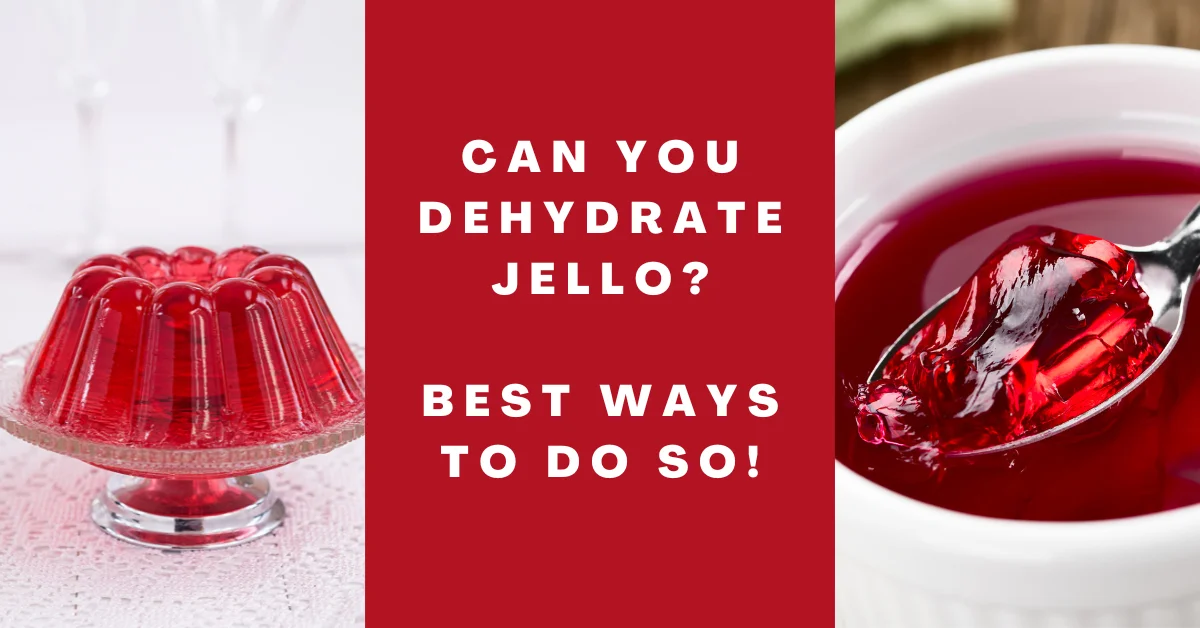Jello is a delicious low-calorie delight that people eat as a snack or dessert. It is primarily made up of gelatin, which gives it a jiggly texture. However, many people prefer drying out jello to make fruit rollups or a crunchy snack to munch on! But how can you dehydrate jello? What’s the exact method?
We have put together a comprehensive guide that will answer all your queries about the dehydration of jello, along with some fun tips and tricks!
Yes, you can easily dehydrate jello by using various methods such as sun drying, air drying, electric drying, and oven drying.
Can you dehydrate jello in a dehydrator?
Yes, you can dehydrate jello in a dehydrator; however, you need to be mindful of the temperature and duration of dehydration. The required temperature is lower than the usual dehydration temperature for this method. Moreover, the dried jello will gain a fruit leather-like consistency.
How do you dehydrate jello?
There are numerous methods that you can employ to dehydrate jello. We have explained a couple of easy ones for you!
Method 1: Dehydrating jello in the refrigerator
This is by far one of the quickest methods for dehydration of jello.
Step 1: Cover in cornstarch
- Take a large dish and sift an adequate amount of cornstarch in it.
- Now, divide your jello into pieces and properly cover each piece with cornstarch.
- Make sure to leave a gap of at least ¼ inch among each jello piece on the dish.
Step 2: Place the dish in the refrigerator
- Place the dish in the refrigerator once you have properly covered all the jello pieces with cornstarch.
- Wait for 6 hours while your jello dehydrates in the refrigerator.
Step 3: Sampling time
- After 6 hours have passed, take out one jello piece and leave it out at room temperature for 15 minutes.
- Dust off the excess cornstarch from that jello piece with a pastry brush.
- Then, chew that piece to determine the level of dehydration you desire.
- Keep sampling a piece every 6 to 8 hours to check for the level of dehydration.
Step 4: Take the dish out
- Once dehydrated sufficiently, take out the entire dish from the refrigerator and store it!
Enjoy dry potato at home with this guide!
Method 2: Dehydrating jello in a freeze dryer
This is another method that will enable you to conveniently dehydrate jello!
Step 1: Place the jello in a large pan
- Take a large pan or dish and carefully place the jello on it.
- In case you are not confident about transferring the entire jello at once, you can cut it into smaller pieces for your ease.
Step 2: Load the jello dish in the freeze dryer
- Load the dish into the precooled freeze dryer.
- Turn up the speed of your freeze dryer to 600x.
- Wait for a few hours, and then take out the dish once you observe that the jello has adequately dried.
- You can determine whether the jello has dried or not by breaking it. If it feels crunchy, that means your jello has dried completely.
Method 3: Dehydrating jello in a dehydrator
This method is not ideal; however, it does the job of dehydrating jello sufficiently. Remember that you have to monitor the dehydrator while drying your jello.
Step 1: Arrange the jello on the rack
- Lay out the jello pieces on the dehydrator racks.
- Make sure to leave enough room among each jello piece to ensure adequate airflow.
Step 2: Load the dehydrator racks
- Now, place the dehydrator racks in the dehydrator.
- Turn the temperature settings to the lowest possible temperature and let your jello dehydrate.
- Make sure to keep checking the jello while it is dehydrating periodically. If you tend to dehydrate your jello excessively, it will end up becoming rock hard.
- Remember that you’re looking for a fruit leather consistency.
Also read this article how you can drying jackfruits!
Can you rehydrate dehydrated jello?
Yes, you can rehydrate dehydrated jello by pouring some water over it. However, once rehydrated, jello wouldn’t retain its jiggly shape and become slimy, which isn’t too appetizing.
How do you store dried jello?
Dried jello should always be stored at room temperature. Make sure to store it in a cool and dry place with minimum moisture, sunlight, and heat.
What happens when you dry jello?
Once the jello has dehydrated, it becomes extremely crunchy, like light styrofoam. Dried jello retains the original intense jello flavor; however, it becomes super crunchy, unlike regular jello, which is very soft and jiggly.
Speaking of jiggly, here is how you can get dry marshmallows!
Related FAQs on drying jello!
How do you store jello long term?
To store jello long-term, you need to keep it in an airtight container inside the fridge. This will ensure that the jello is kept away from air, light, heat, and moisture.
Another helpful dehydration article that might interest you. Enjoy dry bone broth using this guide!
How long does homemade jello last?
Homemade jello lasts 7 to 10 days in the fridge if it is stored properly without coming into contact with any heat or moisture.
Concluding our thoughts on dehydrating jello!
You can make loads of snacks by dehydrating jello-like crunchy jello balls or chewy fruit rollups! The best way to dehydrate jello is by freeze-drying it; however, you can also dehydrate it using the fridge or the dehydrator. We have explained all the steps to these three methods for your ease. So, grab your jello and get on to dehydrating it right now!
Further read this article on dry broccoli to learn more about dehydration.



